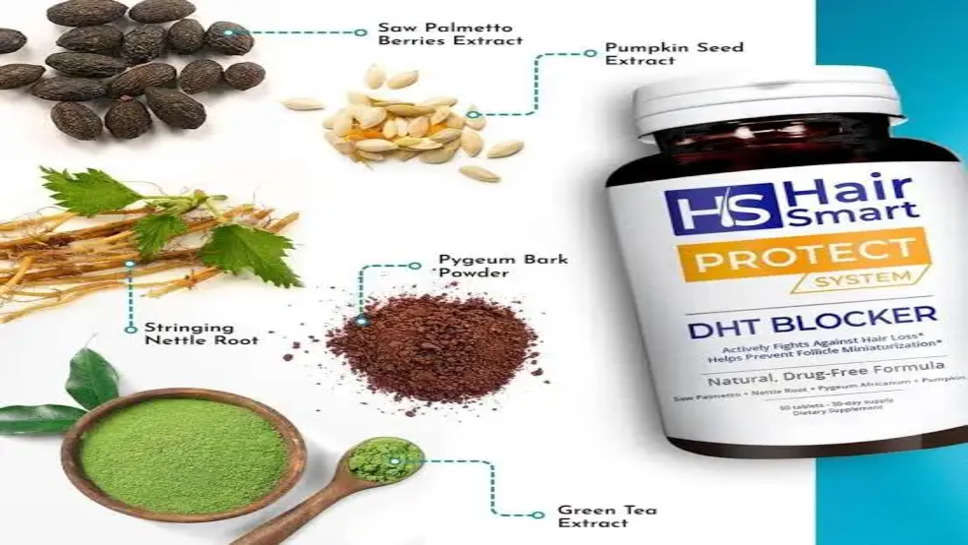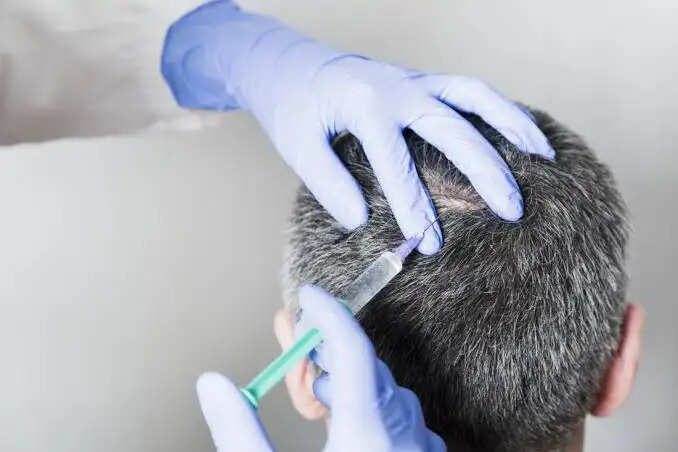What Are DHT Blockers? What Are Its Side Effects?

Life is full of abbreviations... LOL. IMHO. NBD. WTF. We could rattle off dozens. But one you may not be as readily familiar with is DHT.
It's short for dihydrotestosterone, and if you know anything about hair loss, you know that DHT definitely isn't your BFF.
Enter: DHT blockers — hair loss treatments that either cut down the levels of DHT in your body or inhibit the effects of DHT at the scalp level.

Not all DHT blockers are created equally though. While some are backed up by high-quality scientific research, others aren’t supported by, well... much of anything, really. In short, DHT blockers can vary hugely in terms of quality and effectiveness.
It’s our job to help you navigate the lingo and the options to find some HLP — hair loss peace (we just made that one up).
What is DHT?
DHT is the sinister figure walking among your follicles. The main hormone involved in male pattern hair loss, DHT can attach to receptors in your scalp and damage your hair follicles. Over time, this can lead to a receding hairline, hair thinning and even severe hair loss.
DHT, or dihydrotestosterone, is a type of androgen (male sex hormone) — the most potent one produced by your body. Your body produces DHT as a byproduct of testosterone through the action of an enzyme called 5-alpha-reductase.
Like other androgens, DHT is highly important for your development as a male —you could say it writes your genetic bro code.
During the fetal development process, it plays a key role in producing your male genitalia. During childhood and puberty, DHT is responsible for your body hair, facial hair, deep voice and other male features.
In short, DHT is one of the hormones that makes you, as a man, male, at least during the early phases of your life.
DHT Hormone and Balding in Men:
Unfortunately, not all the things DHT is responsible for are desirable, kind of like how you won’t enjoy spicy food as much the next morning. After puberty, DHT takes on another, crappier role as a hairline ruiner.
When DHT binds to receptors on hair follicles, it causes them to go through a process called miniaturization, in which the anagen phase of the growth cycle becomes progressively shorter. This reduced anagen phase results in hairs that are likewise thinner and shorter.
Over time, as each hair follicle goes through a shorter anagen phase, new hairs eventually become so small that they’re unable to penetrate through the skin, like those seeds you planted in third grade science class that never came up.
This type of hair loss is referred to as androgenetic alopecia, or male pattern baldness. It tends to begin as mild thinning around your hairline, and over the course of years or decades, it may also affect your crown. Eventually, it can cause significant hair loss across most of your scalp.
Not everyone is equally sensitive to the effects of DHT, which is why some men go bald early in life while others maintain a full head of hair well into old age.
Researchers believe that men affected by androgenetic alopecia tend to have higher levels of the 5-alpha-reductase enzyme, which converts testosterone into DHT, as well as an increased level of androgen receptor activity in the scalp.
There’s a lot more to this — if you’re interested, our guide to DHT and male pattern baldness goes into more detail about what DHT is and the effects it can have on your hair follicles.
Do DHT Blockers Actually Work?
So, do DHT blockers work? The answer to this question largely depends on your definition of “effectiveness.”
DHT blockers do not magically reverse the effects of male pattern baldness. With the exception of hair transplant surgery, there’s no way to instantly restore a receding hairline or other consequences of pattern hair loss.
If you have realistic expectations though, then some DHT blockers — the ones supported by high-quality scientific evidence, at least — can stop, slow down or partially reverse the effects of male pattern baldness.
But which one(s) you choose is important to your results. DHT blockers come in two main forms. Some, such as the hair loss medication finasteride, stop DHT from being produced from testosterone by blocking the effects of certain enzymes, such as 5-alpha reductase.
Others, such as DHT blocker shampoos, conditioners and hair oils, work by blocking the effects of DHT at specific parts of your body, such as the scalp.
What Are the Best DHT Blockers?
Like we said earlier, not all DHT blockers are equal. These treatments for hair loss aren’t all supported by a substantial amount of scientific evidence.
Of the DHT blockers on the market, finasteride is far and away the best DHT blocker. It's approved by the FDA, it's backed up by plenty of actual research, and it's readily available following a consultation with a healthcare professional.
OTC shampoos, conditioners and other supplements work differently and to varying degrees.
Although DHT-blocking shampoos can produce improvements in hair growth, there’s not nearly as much scientific evidence to support their benefits as there is for finasteride.
Look for the following ingredients when you’re comparing hair loss shampoos:
1. Ketoconazole: An antifungal medication, ketoconazole is commonly used to treat fungal skin infections such as athlete's foot (tinea pedis). It’s also known to inhibit 5α-reductase, the enzyme that converts testosterone into DHT. Research suggests that ketoconazole shampoo can increase hair density and stimulate hair follicles to enter the anagen phase of the hair growth cycle.
2. Saw palmetto: Saw palmetto is a popular natural ingredient that’s produced from a palm called Serenoa repens. A study published in the journal Urology found that it can reduce DHT levels in prostate tissue when taken as a supplement. Other research has found that saw palmetto can produce improvements in hair growth for men with pattern hair loss. You can find saw palmetto in our hair thickening shampoo, which is formulated to target DHT and promote volume and moisture.
Pumpkin seed oil. Pumpkin seed oil is a natural product that’s been linked to improved hair growth. In one study, researchers found that it may stop prostate growth — an issue that’s often caused by high DHT levels — when used with saw palmetto. Other research suggests that pumpkin seed oil supplements can increase hair growth in men with male pattern baldness.
In general, it’s best to use hair loss prevention shampoo with finasteride, rather than on its own as a hair loss treatment. Our guide to DHT-blocking shampoos explains more about how a hair loss shampoo can fit into your hair care routine for optimal results.
Side Effects of DHT Blockers:
DHT blockers are safe and effective for most men, so you don’t have to worry about weird DHT blocker side effects like hairy palms from scrubbing these shampoos into your hair. However, some DHT-blocking medications may cause other side effects — including sexual ones.
The most common side effects of finasteride include decreased libido, erectile dysfunction (ED) and ejaculation issues, such as a reduction in semen volume.
These side effects only affect a small percentage of men who use finasteride. For example, data from clinical trials shows that erectile dysfunction — the most publicized side effect of finasteride — only occurred in 1.3 percent of men who used it at the standard 1mg dose.
Side effects from DHT blockers used in hair loss prevention shampoos are similarly uncommon, though some ingredients may cause irritation, dry skin, itchy skin or other minor side effects.
If you experience any side effects while using finasteride or a topical DHT blocker, it’s important to let your healthcare provider know.


